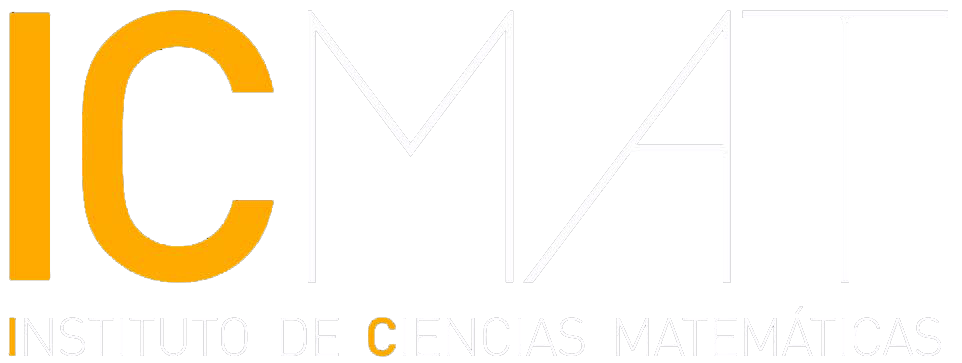Interview with Nigel Hitchin (University of Oxford), Ngô Bảu Châu (University of Chicago), chairs, and Oscar García-Prada (ICMAT-CSIC) coordinator of one of the ICMAT Laboratories
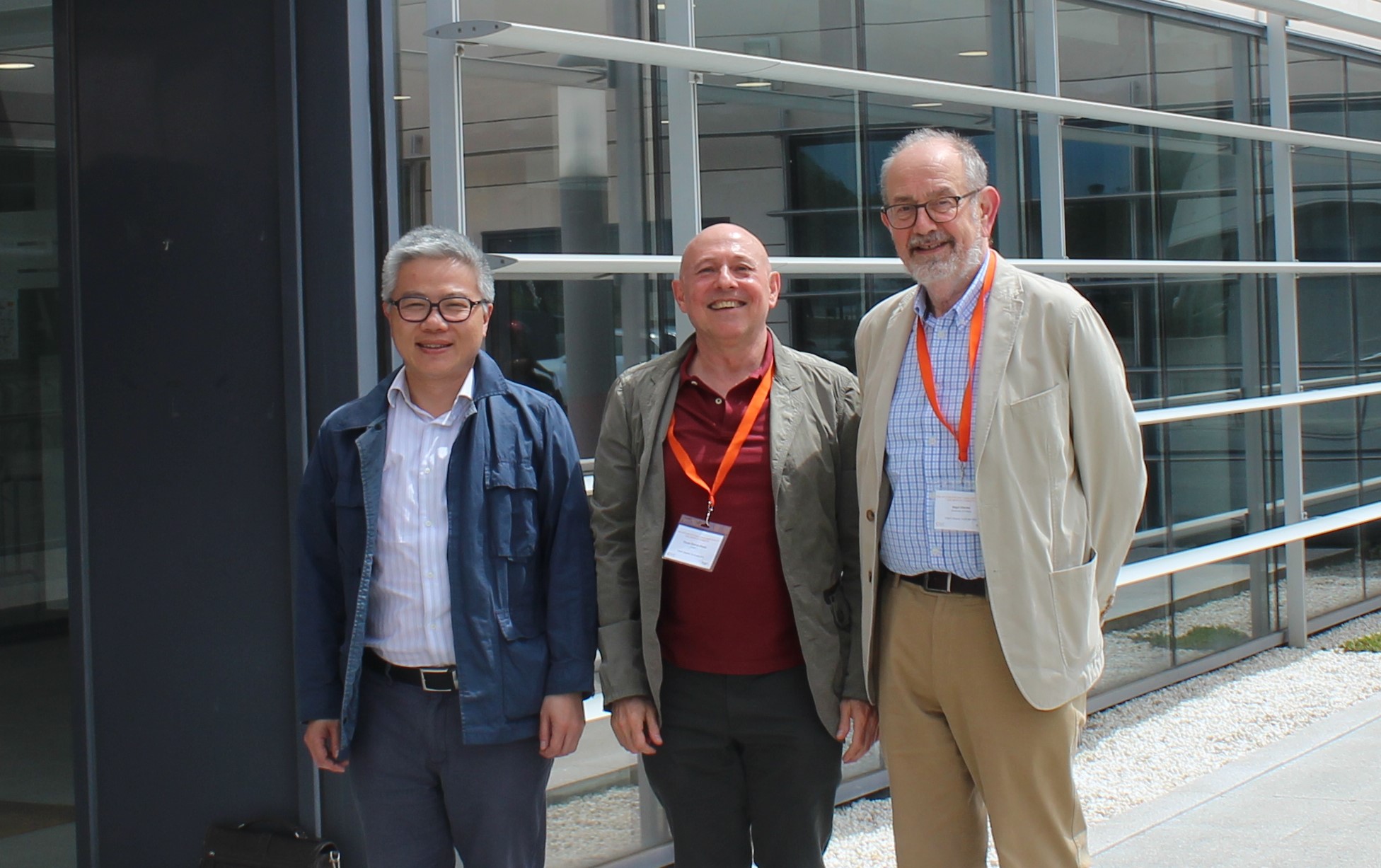
From left to right: Ngô Bảo Châu (University of Chicago), Oscar García-Prada (ICMAT-CSIC) and Nigel Hitchin (Oxford University) at the ICMAT. Image: Ágata Timón/ ICMAT.
The “Nigel Hitchin–Ngô Bảu Châu” Laboratory is an initiative funded by the Severo Ochoa programme of ICMAT, which promotes international collaboration in research on various topics in geometry and mathematical physics. The programme, coordinated by Oscar García-Prada, research professor at the Spanish National Research Council (CSIC) within ICMAT, and led by Nigel Hitchin, Emeritus Savilian Professor of Geometry at the University of Oxford (UK) and Ngô Bảo Châu, Francis and Rose Yuen Distinguished Service Professor at the University of Chicago (USA), addresses subjects such as the Hitchin system, Langlands duality, mirror symmetry, Higgs bundles, character varieties, higher Teichmüller theory, gauge theory, moduli spaces, and geometric structures.
The groundbreaking work of Hitchin — recipient of numerous awards, including the 2016 Shaw Prize in Mathematics — spans the fields of differential and algebraic geometry and mathematical physics. Hitchin’s contributions have opened up new research areas and have been applied in various contexts, such as string theory and supergravity. In 1987, he introduced the Hitchin fibration of the moduli space of Higgs bundles, which played a crucial role in Ngô’s proof of the fundamental lemma for automorphic forms, a key result in the Langlands programme initiated by Robert Langlands and Diana Shelstad. This achievement earned Ngô, a leading expert in algebraic geometry, number theory, and geometric representation theory, the Fields Medal in 2010.
The first Hitchin–Ngô Lab took place from 2021 to 2024, when various research activities were organized, with a special extended programme on moduli spaces and geometric structures held from April to June 2023. On the occasion of the first of three workshops organized within this framework — “The Hitchin system, Langlands duality and mirror symmetry“, April 2023 — we were able to speak with the two chairs and the coordinator of the Lab about the research they are conducting.
Now, a new edition of the Lab has just begun in 2024 and will run until 2028, with new research challenges and a variety of activities. Among these, an extended activity, during the whole month of June of 2025, an a new extended research programme, set to take place in the autumn of 2026, stand out. This programme will also include a very special conference to celebrate Nigel Hitchin’s 80th birthday.
Ágata Timón G Longoria (ICMAT)
What is the general topic of research for the Laboratory?
Nigel Hitchin: In a way, we have complementary points of view over the same object: the Hitchin system. This is a fundamental geometrical object, which relates to our previous work. In my case, coming from gauge theory, which comes originally from theoretical physics, but it has now become a big part of pure mathematics.
Ngô Bảo Châu: My approach comes from the Langlands programme, starting from number theory and coming into representation theory, harmonic analysis and groups. But we were studying the same object.
Hitchin: That is what brings us together. And, in fact, this particular workshop is a way for the younger generation of mathematicians from both sides [complex geometry, Langlands programme], of interacting and adopting the points of view of the other side. And hopefully using them to further their research in a more profound way.
Oscar García-Prada: The scope of the Laboratory is, of course, larger. In this workshop we bring together the expertise of Nigel and Châu; in the next one [“Higgs bundles, character varieties and higher Teichmüller spaces” workshop, May 2023], about Higgs bundles and the Teichmüller theory, we gather experts in geometric group theory, hyperbolic geometry, Higgs bundles, and related fields. In this case, the interaction has been going on for a longer time and has been extremely fruitful. Now we have a generation of young mathematicians familiarized with these topics. In a sense, the purpose of this Lab has been trying to do that in the intersection of Langlands duality, mirror symmetry, etc. And it has been very successful.
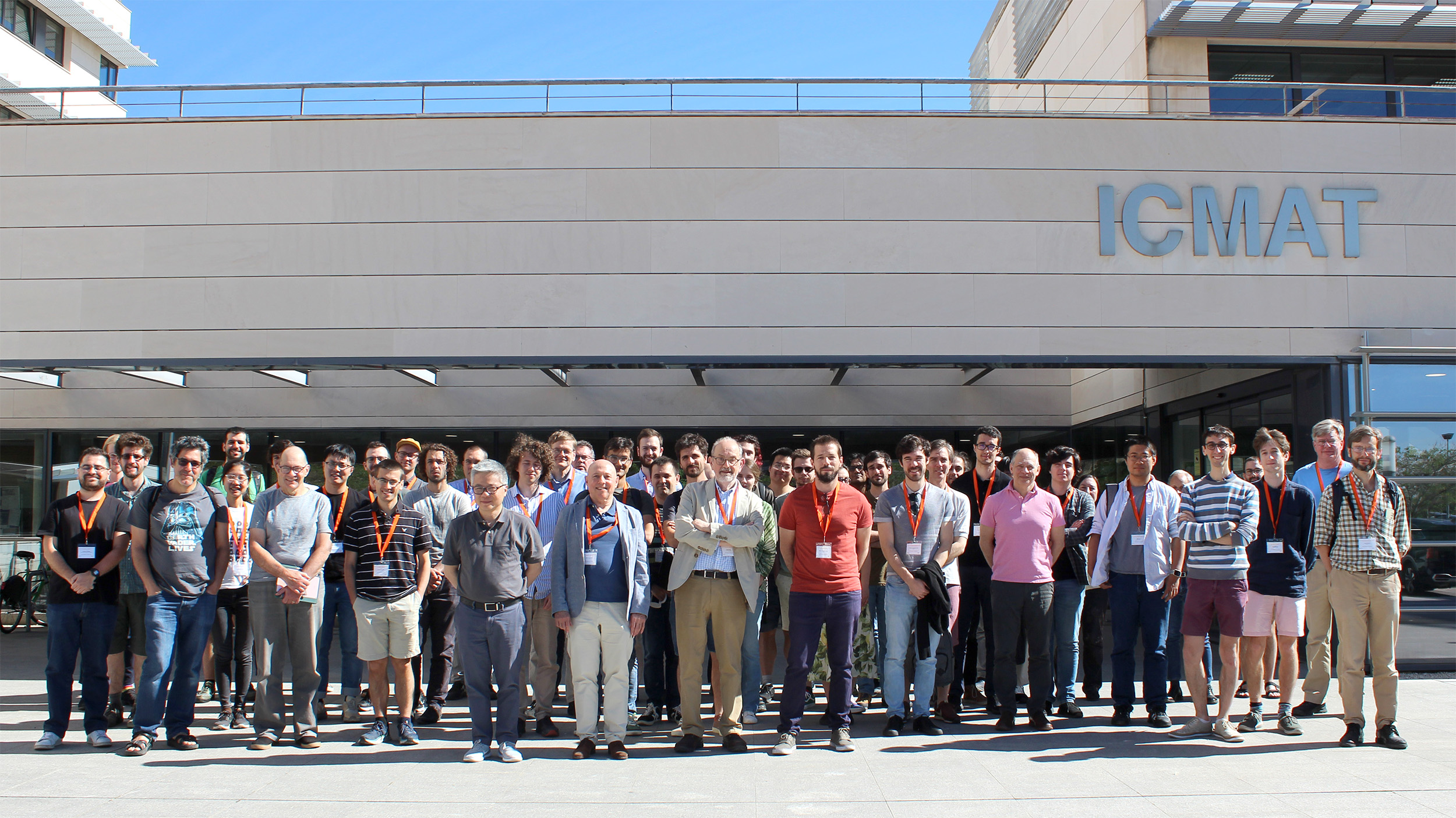
The conference ‘The Hitchin system, Langlands duality and mirror symmetry’ was held in April 2023 within the framework of the Laboratory. Image: Laura Moreno Iraola/ ICMAT.
Coming from different mathematical backgrounds, how did you start collaborating?
Hitchin: Our relationship it is not exactly a collaboration, more like a common interest. I guess, maybe it started with the Hitchin system.
Ngô: I came across the Hitchin system in a rather casual way. I was reading an article by my thesis advisor [Gérard Laumon] in a journal and, right after it, there was “Stable bundles and integrable systems”, an article by Nigel Hitchin. I started reading it. I was already curious. This paper was very popular and widely cited, so I was very curious about what it was about. It was my first encounter with this paper and I must say that on the first reading I understood it, but I, somehow, passed on why it was so important. However, after my PhD thesis, I got some ideas on how one should prove the fundamental lemma [proposed by Robert Langlands and Diana Shelstad], but there was a missing step that ruined my reasoning. Only four years after my first reading of Nigel’s paper, I found that this paper had exactly what I needed. But it was not in the first reading, it was a long process to figure that out: our ideas came from very different mathematical disciplines.
Ngô: “Four years after my first reading of Nigel’s article, I discovered that it contained exactly what I needed [to prove the Fundamental Lemma].”
How did you come to propose the Hitchin system?
Hitchin: For me, it started almost by accident as well. Thirty-five years ago, I was constructing a certain moduli space. I was interested in its topological and geometric properties, in terms of differential geometry. Then I observed that there was an integrable system, which I knew something about, from a different context. It was there, everything fitted, and it just seemed so nice. At that time, it wasn’t really a fundamental part of what I was trying to do with this moduli space. But then, subsequently, it appeared that it was much more fundamental in this picture.
How did this system become so important for a broader community?
Hitchin: Some physicists started to use this moduli space and showed that there might be some relationship with the Langlands programme. Then it became clear that actually the integrability of the system, what was originally just an observation I noticed by chance, was a more fundamental feature. It wasn’t constructed by design. It was there by chance. But this brings us to the classical question: What do mathematicians do? Do we discover, or do we invent? In a way, it was destined to exist and be discovered at some stage. I happened to come across it.
How are these ideas linked with the work of the algebraic geometry and mathematical physics group at ICMAT?
García-Prada: Nigel has papers on these topics dating back at least 50 years. The paper we are referring to, by Nigel, incorporates this aspect with integrable systems and the Hitchin fibration, from which Châu bought a house [laughs], but there are numerous other groundbreaking elements in this work. For example, the link to what are called character varieties, the non-abelian Hodge correspondence. That relates to representations of fundamental groups of surfaces. And that opened up a new area of research that links with this other workshop [“Higgs bundles, character varieties and higher Teichmüller spaces”] that we organize in this research period. Nigel’s contribution on Higgs bundles has so many directions: Langlands, duality, mirror symmetry, character varieties, higher Techmuller theory…

Copy of the article ‘The self duality equations on a Riemann Surface’ that Hitchin gave to Garcia-Prada in 1987 in Oxford. Image: Ágata Timón/ ICMAT.
How did you start getting interested on these subjects?
García-Prada: I was a student of Nigel at the University of Oxford in 1988, but I was a visiting student in 1987. I was there for the summer, to learn about bundles, so he gave me a copy of “The self duality equations on a Riemann surface”, that had just come out. I still have it! I thought it looked very beautiful. When I went back to Rice University, where I was a graduate student at the time, I put everyone on the mathematics department to work on that paper. We had a working seminar for one semester.
Why was this object so fascinating?
Ngô: Nigel’s Higgs fibration is one single object which connects to so many areas of mathematics. It is really interesting that we are all thinking differently about the same object. Some question that Nigel asked about it, I would have asked conversely. This keeps happening with this subject: in this conference, a new proof of my fundamental lemma was presented by Michael Groechenig [also speaker at the “The Hitchin system, Langlands duality and mirror symmetry” workshop]. They are studying the same problem I studied but with a different point of view. I am very happy to see this exchange between different angles, it reveals more and more beauty in mathematics.
Ngô:: “The exchange between different approaches reveals increasing beauty in mathematics.”
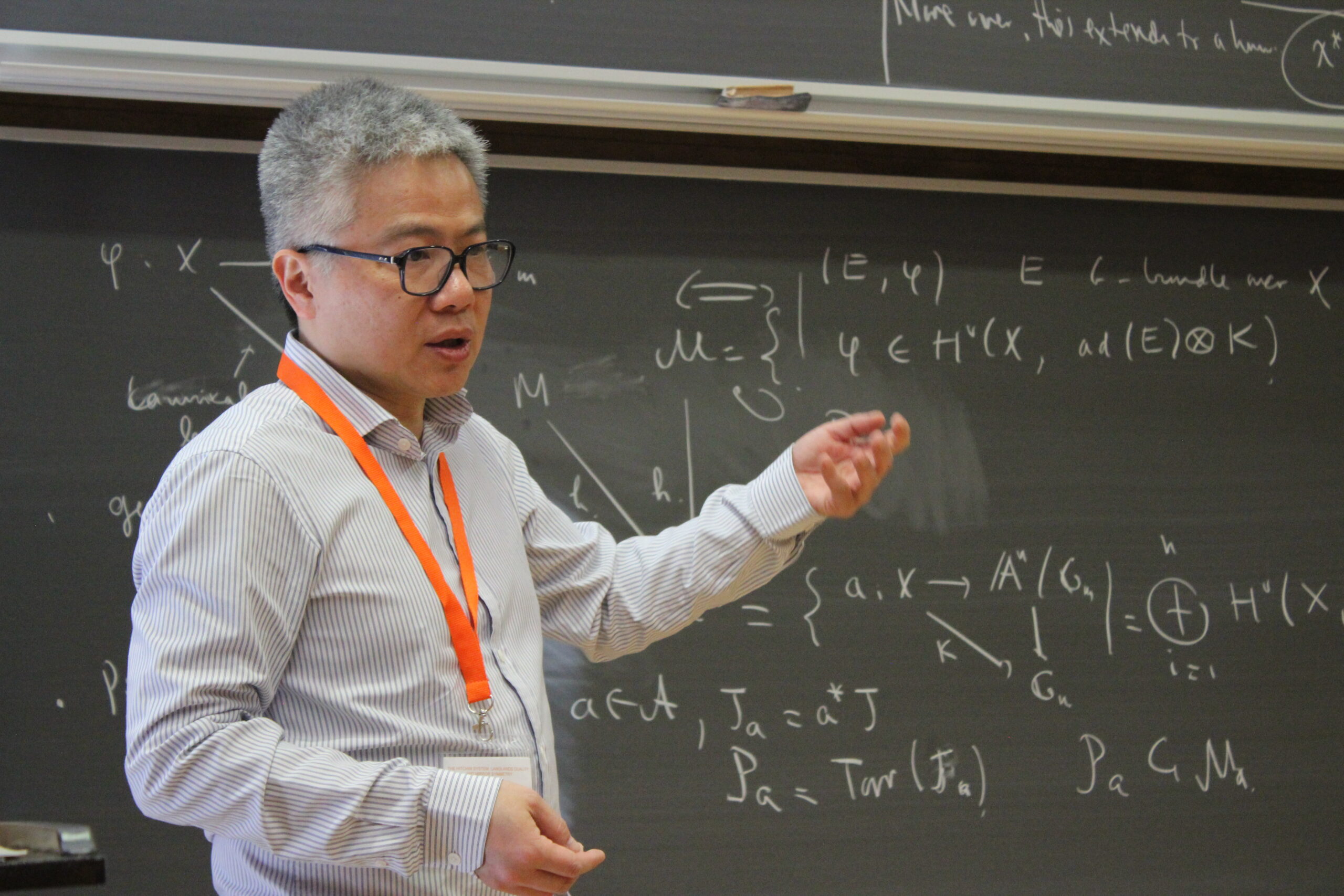
In 2010, Ngô was awarded the Fields Medal for his proof of the fundamental lemma of automorphic forms. Image: Laura Moreno Iraola/ ICMAT: Laura Moreno Iraola/ ICMAT.
When did you first meet?
Hitchin: Maybe at the Fields Institute. At a Fields Symposium [Fundamentals of the Langlands programme, 2012].
Ngô: I remember I visited Oxford a little bit before that, invited by Tamás Hausel [IST Austria, minicourse speaker at the “The Hitchin system, Langlands duality and mirror symmetry” workshop].
Hitchin: Yes, Tamás had a position in Oxford at that time. He has a more algebraic viewpoint than I do, and he was also interested in putting our two communities together.
Ngô: At that time, 15 years ago, even if we study pretty much the same thing, it was very hard to understand each other. Now it is better. We had Tamás who understands both worlds.
Hitchin: And then there was this Fields Symposium. I delivered a presentation on the history of this fibration [“Higgs bundles, past and present”] from my perspective. I highlighted the moment when the main idea occurred to me while visiting Jacques Hurtubise in Canada, at his cabin in the mountains. I was sitting there, with a piece of paper, and suddenly the idea came to me. When I mentioned this during the lecture, Gérard Laumon [Ngô’s thesis advisor], who was among the audience, was delighted that this occurred in French Canada.
García-Prada: A few years later, Tamás also played a role in facilitating our collaboration. He was coordinating a research programme in Lausanne, where he was a professor at the time, and asked me to contribute to it, organizing a workshop. Consequently, I spent a month there and took the opportunity to invite Nigel and Châu to join as well. Somehow, this interaction led to the establishment of our ongoing collaboration.
It was then when you started collaborating?
Ngô: In Lausanne, I attended Nigel’s talk — about mirror symmetry, BBA branes, and so on — and I began to realize that we were contemplating similar ideas.
Hitchin: Constructing these bridges takes time. Châu had to read my original paper multiple times. Our perspectives were initially quite far apart. It is through attending talks on these subjects repeatedly that the crucial aspects start to make sense over time. This underscores the significance of gatherings like this.
García-Prada: Absolutely. Moreover, the impact is more pronounced with the younger generation who bring a fresh approach, learning diverse techniques that can effectively create these connections.
Hitchin: “When you repeatedly hear talks on these topics, the important aspects gradually settle in.”
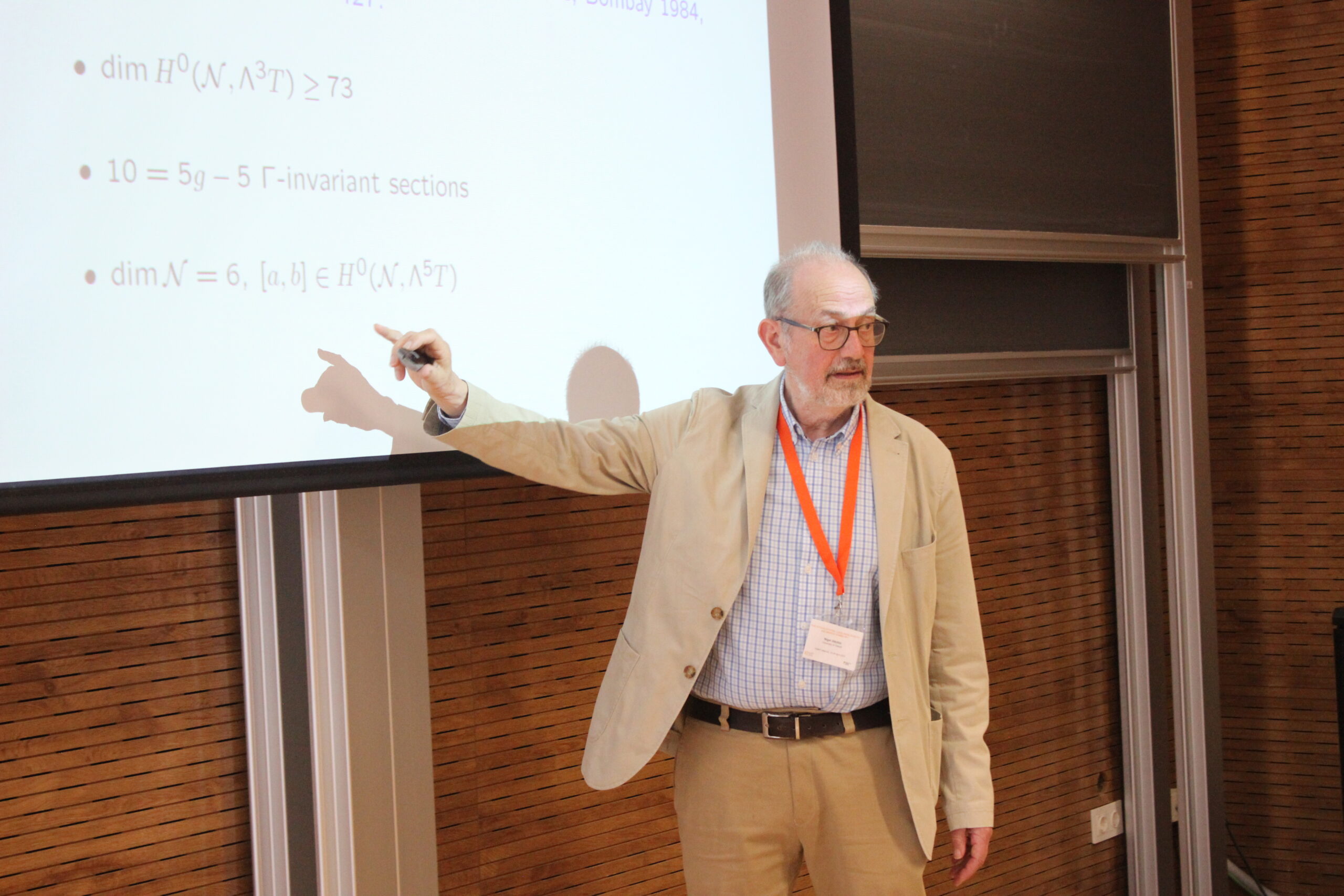
4. Hitchin’s numerous honours include the Shaw Prize in Mathematical Sciences (2016), the Whitehead Prize (1980), the Berwick Prize (1990) and the Polya Prize (2002), as well as the Sylvester Medal of the Royal Society (2000). Image: Laura Moreno Iraola/ ICMAT.
What results would you like to see resolved in the upcoming years in this field?
Ngô: There are so many new questions! This area is getting connected to many others in mathematics very fast. I would love to see what these younger researchers can do.
Hitchin: We can already observe some compelling connections with mirror symmetry. However, certain questions anticipated by physicists in the context of mirror symmetry have yet to be fully resolved. While some have been addressed and seem to work, they often do so in an “unofficial” manner. Even in cases where we understand the underlying concepts, there is a need for mathematical consolidation. In other instances, particularly concerning real forms, BAA branes, or their mirror counterparts, the situation is not entirely clear. A few years back, during the Lausanne conference that Oscar mentioned, these questions were raised. At that point, we required more information to ascertain what the mirrors would entail. Once the mirror concept is established through examples, that is when we can begin the process of mathematical consolidation. Given that mirror symmetry has wielded persuasive influence in this field over the past 10-15 years, it is now time for more rigorous propositions to take shape. While there are sporadic instances, I believe there is a larger framework that needs attention. This framework has indeed been addressed, but I am hopeful that we will discover some resolutions.
García-Prada: This connection to mirror symmetry draws significant inspiration from the work of physicists. In fact, we have two of the individuals who pioneered this field — Philip Candelas and Xenia de la Ossa — included in the programme. Many of the assertions they make about what “must happen” have led to remarkable mathematical developments, but the challenge lies in proving them. As Nigel mentioned, we have witnessed scattered outcomes, yet a substantial amount of rigorous mathematical proof remains to be accomplished.
Hitchin: “We know there are connections between the Hitchin system and mirror symmetry, but we need to mathematically consolidate them.”
How could the Laboratory contribute to that?
García-Prada: One of the primary achievements of the Laboratory lies in these broader generalizations of the Hitchin system, as Châu outlined in his initial presentation on the workshop. While these extensions might initially appear too general, they often serve as essential tools for understanding what the real problem is. By expanding the scope of the concept to encompass other similar situations, we can eventually arrive at the heart of the matter in mirror symmetry or even Langlands’ duality correspondences. Currently, we are dealing with relative Langlands’ geometric correspondences. I believe that delving into these various generalizations, particularly with the involvement of young researchers, will likely prove beneficial.
After this conference, is any other challenge related to this field that you would like to highlight?
García-Prada: The last talk of the conference, given by Tamás Hassel, was a programmatic proposal, where he has given us work for the next twenty years or so [laughs]. That is definitely one place to look for future and it was very influenced by the work that we have done during the Lab activities. One ICMAT student, Miguel González, went and visited Tamás — also as part of the Lab — and discussed about the real forms; after that, Tamás got converted to the study of involutions in the context [laughs].
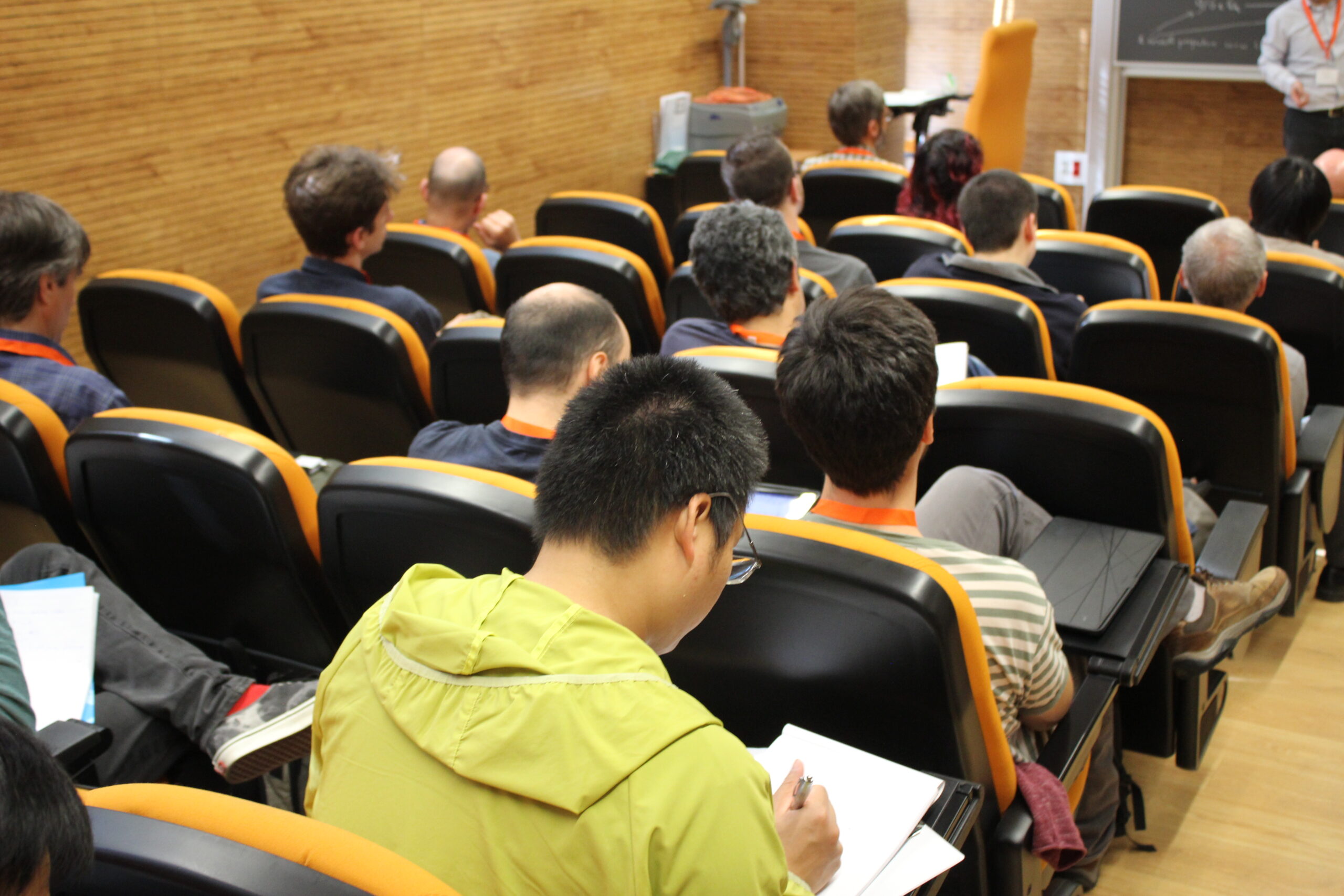
The Laboratory deals with topics such as the Hitchin system, Langlands duality, mirror symmetry, Higgs fibria, character varieties, higher Teichmüller theory, gauge theory, moduli spaces and geometric structures. Image: Laura Moreno Iraola/ ICMAT.
How has your experience been working here at ICMAT?
Hitchin: My association with ICMAT goes back a long way. In fact, I was part of the external committee that discussed the establishment of an institute like this in Spain. I have been visiting Madrid since before then. I believe the creation of ICMAT has brought about a significant change in the way mathematical research is conducted in Spain, particularly in Madrid. It has fostered an environment where hosting visitors is much smoother, and the number of students coming here has increased, making the atmosphere more vibrant.
Ngô: My involvement with ICMAT is more recent, but it has been very pleasant. I have visited Madrid, and I have also hosted Oscar and Guillermo [Gallego] in Chicago. We started conversations, and our students are collaborating as well. It has been a wonderful experience.
García-Prada: Indeed, and I am also planning to visit Châu in Paris at the Collège de France and in Vietnam at the Institute of Advanced Studies in Mathematics, of which he is the director, to further establish connections.
Hitchin: “The establishment of ICMAT brought about a radical change in the way mathematical research is conducted in Spain.”
How would you describe your experience with the third edition of the Geometry Lab at ICMAT?
García-Prada: All three editions have been excellent. The first one was with Nigel. The second edition was also with Simon Donaldson and focused more on connections to differential geometry. This led to ideas related to Kähler metrics and Yang–Mills connections, which are related to Simon Donaldson’s recent work — that was also very significant for our group. Now, in this third Lab with Châu, the subject matter has been very new to me. The kind of mathematics Châu works on is quite challenging for me. However, learning about it has been extremely rewarding, not just for myself but also for the younger generation. These Labs have a profound impact on the younger researchers.
How has it been working with these young students in the Lab?
Ngô: I have been hosting Guillermo [Gallego] for one month, and my PhD and postdoctoral students also visited ICMAT [Thomas Hameister and Benedict Morrissey, both from the University of Chicago].
García-Prada: This exchange has been highly beneficial for both the students and us. Benedict came here in August 2022 when the Institute was relatively quiet, so we had an intensive workshop with just my students and Benedict. It was quite an intense experience.
Hitchin: I have had interactions with Oscar’s students for many years. I have had the pleasure of hosting many of them at Oxford. Also, one of the most valuable aspects of my regular visits to ICMAT is the opportunity to learn about the research of young students. Sometimes, we organize a day where students and postdocs give presentations. It requires preparation from them, helping them learn about giving talks, but it is also a way to exchange ideas and receive feedback within the group. They share their partially formed ideas and receive input. Everyone becomes aware of what others are working on. These are really wonderful occasions.
García-Prada: Absolutely, for two days, all the doctoral and postdoctoral students presented their results for half an hour each. We learn a lot from each other, and it fosters a sense of cohesion within the group. Additionally, on a broader level, through such activities, we have started to share ideas with the Institute of Theoretical Physics, particularly related to moduli spaces. For around 15 years, our groups were essentially working separately, but we have a lot of common ground.
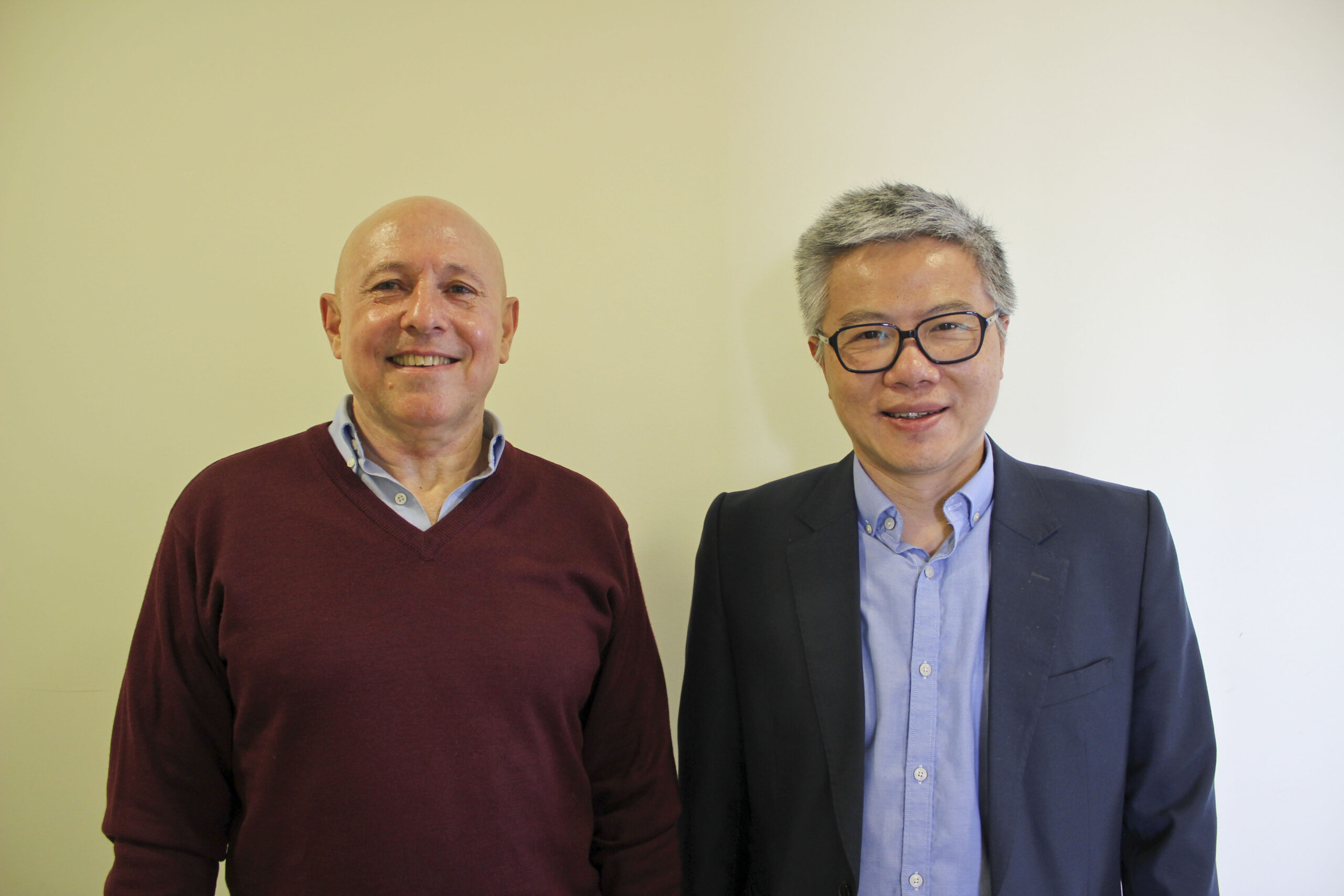
In 2022, Ngô and Garcia-Prada received a group of 6th graders from the Lycée Français at the ICMAT. Image: Laura Moreno Iraola/ ICMAT.
In April 2022, you also organized an informal talk with 6th-grade students from the Lycée Français (aged 12) related to an exhibition on ethnomathematics organized in collaboration with the UAM. How was that?
García-Prada: Yes, it was a remarkable opportunity to engage with a different community through our Lab. A group of students visited ICMAT after attending a photography exhibition on Kolam by Claudia Silva at the UAM. Châu gave them a talk in French, during which they could ask questions. One student, in particular, asked very insightful and relevant questions. Despite his young age, you could sense a mathematician within him.
Ngô: Yes, I remember that student; he asked incredibly precise questions. It is wonderful for ICMAT to engage in such activities, connecting with schoolchildren and sparking their interest in mathematics and science. We are able to introduce them to the captivating world of mathematics.
García-Prada: It was an inspiring experience for all of them. They were all excited, and they kept asking, “When will Châu come back?” Our outreach programmes provide a platform for interaction with the lab, capitalizing on the expertise of the exceptional mathematicians who visit here. They can conduct sessions with the children, which could be highly beneficial.
Nigel Hitchin is Savilian Professor Emeritus of Geometry at the University of Oxford (UK). He completed his PhD at the same university under the supervision of Sir Michael Atiyah and subsequently held a postdoctoral position at the IAS from 1971 to 1973. After a year at the Courant Institute (USA), he returned to Oxford. He was a Mathematics professor at the University of Warwick (UK) from 1990 to 1994 and at the University of Cambridge (UK) from 1994 to 1997. In 1997, he returned to Oxford. Among his numerous honours are the Shaw Prize in Mathematical Sciences (2016), the Whitehead Prize (1980), the Berwick Prize (1990), and the Polya Prize (2002), as well as the Sylvester Medal of the Royal Society (2000). He is a Fellow of the Royal Society and the American Mathematical Society.
With a PhD in Mathematics from the University of Paris Sud, Ngô Bảo Châu was a CNRS Fellow at the University of Paris Nord from 1998 to 2004, a professor at the University of Paris Sud from 2004 to 2007, and a member of the Institute for Advanced Study in Princeton from 2007 to 2010. He then moved to his current position — Francis and Rose Yuen Distinguished Service Professor — at the University of Chicago. Additionally, he holds a visiting chair position at the Collège de France and serves as the scientific director of the Institute for Advanced Studies in Mathematics in Vietnam, that he founded, since 2011. Ngô was a keynote speaker at the 2010 ICM in Hyderabad, where he received the Fields Medal. Alongside this recognition, he has been awarded the Clay Research Award (2004), the Sophie Germain Prize (2007), the Oberwolfach Prize (2007), and the Légion d’honneur (2011). He is also a Fellow of the American Mathematical Society, the American Academy of Arts and Sciences, a foreign member of the Paris Academy of Sciences (2016), and honorary member of the London Mathematical Society (2021).
Oscar García-Prada is a CSIC Research Professor at ICMAT. He obtained his PhD in Mathematics from the University of Oxford in 1991, under the supervision of Nigel Hitchin and Sir Simon Donaldson, followed by postdoctoral positions at the Institut des Hautes Études Scientifiques (France), the University of California, Berkeley (USA), and the University of Paris-Sud (France). He subsequently held positions at the Autonomous University of Madrid and the École Polytechnique (France). He joined CSIC in 2002 and has been part of ICMAT since its inception. An expert in the study of moduli spaces and geometric structures, he has authored articles in internationally prestigious journals such as Annals of Mathematics, Inventiones Mathematicae and Duke Mathematical Journal, among others. He has collaborations in Spain, the USA, the UK, France, Germany, Portugal, Italy, Switzerland, Canada, and India. He has supervised around 15 doctoral theses and more than 10 postdoctoral researchers, and has been the principal investigator for over 40 national and international research projects.
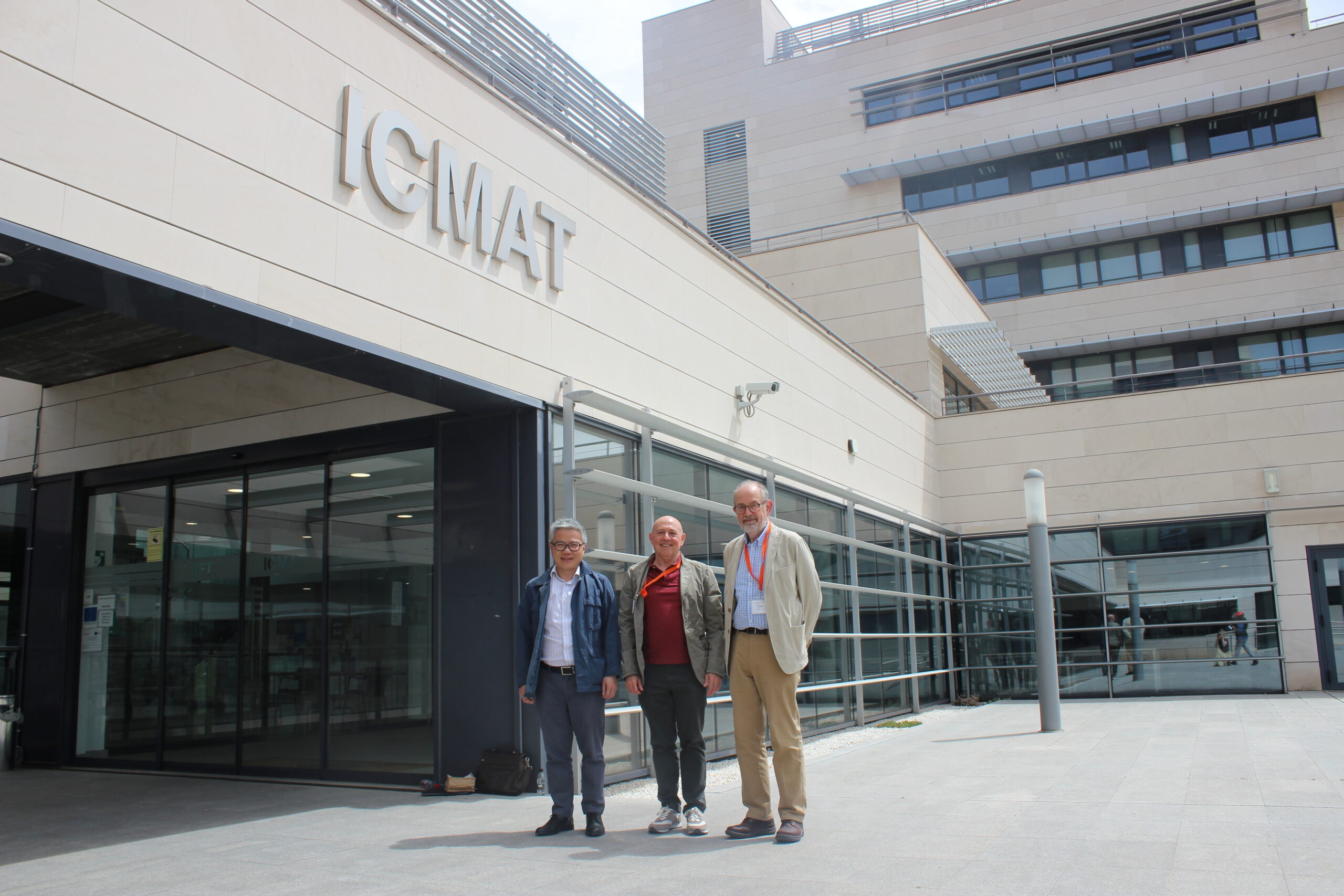
ICMAT Laboratories, Programmes for Strengthening International Collaboration
The fourth edition of the Severo Ochoa Distinguished Laboratories and Visiting Professors Programme has begun in the last quarter of 2024. Among the 14 individuals joining ICMAT through these programs are two Fields Medalists, a Shaw Prize laureate, the 2006 Prince of Asturias Award for Scientific and Technical Research winner, and the director of the Clay Mathematics Institute, along with many other distinguished accolades.
All of them will collaborate with ICMAT research groups until 2028, working on highly active research areas such as quantum computing, fluid mechanics, dynamical systems, geometric integration, and neural network analysis.
“The activities generated by each of these groups will serve to attract a significant number of visitors to the institute, increase the scientific cohesion of our research teams, and reinforce ICMAT’s position as an undisputed reference point within the international mathematics community,” said Javier Aramayona, director of ICMAT.
In addition to Nigel Hitchin and Ngô Bảo Châu, the Severo Ochoa Distinguished Laboratories and Visiting Professors Program for 2024–2028 includes the following researchers:
- Bruno Anglès (Université de Caen Normandie).
- Martin Bridson (University of Oxford), Clay Mathematics Institute director.
- Elena Celledoni (Norwegian University of Science and Technology).
- Ignacio Cirac (Max Planck Institute for Quantum Optics), 2006 Prince of Asturias Award for Scientific and Technical Research.
- Charles Fefferman (Princeton University), Fields Medal (1978).
- Monika Ludwig (Vienna University of Technology).
- Eugenia Malinnikova (Stanford University).
- Eva Miranda (Polytechnic University of Catalonia).
- Gilles Pisier (Texas A&M University, Université Pierre et Marie Curie)
- Alan Reid (Rice University).
- Eero Saksman (University of Helsinki).
- Mikael de la Salle (École Normale Supérieure de Lyon).
